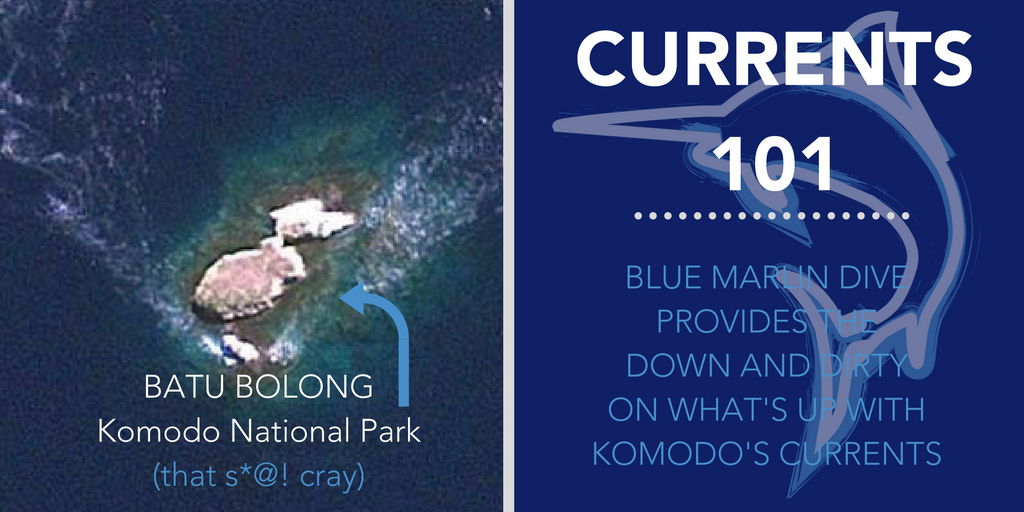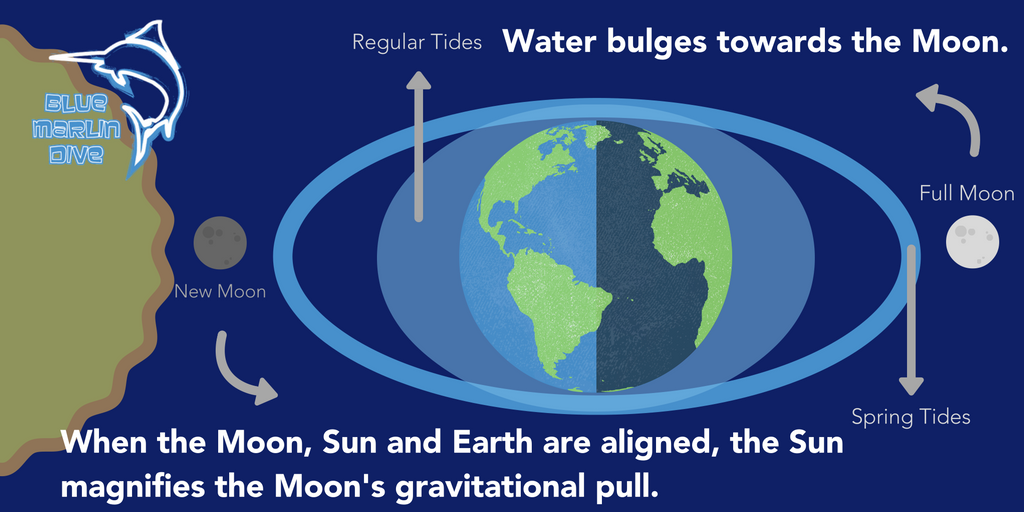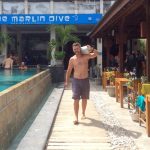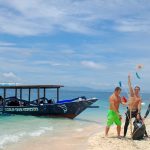 Welcome to Komodo 101: Intro to Currents. I assume you’ve already read your provided materials such as “Komodo National Park: Some of the Best Diving in the World” and “Blue Marlin Dive: Riding Komodo Dragons Since 2001”. We’ll move on.
Welcome to Komodo 101: Intro to Currents. I assume you’ve already read your provided materials such as “Komodo National Park: Some of the Best Diving in the World” and “Blue Marlin Dive: Riding Komodo Dragons Since 2001”. We’ll move on.
This past month there has been a lot of talk of Komodo’s currents in the scuba channels and ‘zines. GoodVis has a great article that mentions tips and tricks to choosing proper operators and sites for your experience level. ScubaDiverLife has also recently come out with an article on how to tackle an unexpected down current. However, as much as we hear scuba junkies discuss current intensity or how to properly handle mother nature at her angriest, we’ve never really gotten to ‘get our hands dirty’ about what causes the currents in Komodo and how they actually work.
This, class, is an entirely different ballgame.
Maybe you’ve experienced them already, or at least you’ve probably heard about them… Be under no illusions: certain places in Komodo at certain times of the day can be very dangerous places to dive. Bloggers and scuba journalists focus on the integrity and knowledge of Komodo’s dive centres so heavily because, without a proper understanding of the waters here, divemasters and instructors, let alone freshman like you, cannot guide others safely and may even jeopardise their own safety in the process.

Thankfully, you’ve got Blue Marlin Dive. Shall we begin?
So, time for a geography lesson…
Geologically, the key to Komodo National Park’s spectacular array of biodiversity and famous currents is its location between two great seas: the Flores Sea to the North (fed by the Pacific Ocean) and the Sumba Strait/Savu Sea to the south (fed by the Indian Ocean). On a daily basis these waters rise and fall through three narrow channels (the only breaks in a land barrier hundreds of kilometres long), converging in a nutrient rich blend that gives life and splendour to the marine creatures that reside below. It’s basically your kale and beet smoothie of the sea. These breaks are the Lintah Strait directly east of Komodo, the Molo Strait in between Rinca and Flores and the Sape Strait west of Komodo.

Welcome to where we primarily dive: The Lintah Strait. This strait between Komodo and West Flores is marked with multiple islands and relatively shallow seas which magnify these rising and falling tidal currents. The upwellings from the deep surrounding seas bring nutrients and plankton to keep these waters rich and well-fed, making perfect conditions for spectacular scuba diving, although also introducing up currents and down currents in the already quickly moving water.
Have I gotten ahead of myself? Let me take it all the way back to the rising and falling tidal movements.
Tidal movements can be categorised into three parts – Rising, Falling and Slack Tide (when the water pauses briefly between cycles).
- Rising Tide – Water movement is generally from SOUTH to NORTH, rising from the Sumba Strait/Savu Sea toward the Flores Sea.
- Falling Tide – Water movement is generally from NORTH to SOUTH, falling from the Flores Sea back toward the Sumba Strait/Savu Sea.
- Slack Tide – The time between Rising and Falling (and between Falling and Rising) where the water movement essentially pauses.
Easy, right? Now, a few more notes about those ‘simple’ currents we just explained:
- Falling tide generally tends to have a stronger current as the water has less space to flow into.
- In the north of Komodo, the landmass of Komodo Island is blocking the current. Therefore when it is falling, the current flows from WEST to EAST. When it is rising it flows from EAST to WEST.
- Slack tide is a tricky one. Sometimes you will get a very noticeable slack period but sometimes it can change instantly from Rising to Falling (or vice versa) without any slack period whatsoever.
Confused yet? There’s more.
- Sometimes, like at Tatawa Besar, your longshore current will fully overpower the tidal currents. Scrap everything you know. There’s no predicting this one.
- Other times, you’ll hop in to check the current, and it will be pushing hard one way. Hop in, 10 minutes into the dive, you’ll run into a longshore current that lives at a certain depth. Scrap everything you know.
- Within bays, such as Siaba Besar, the current will push so hard that it is funnelled into the bay and creates a current that cycles the opposite way through the bay. Sometimes. Scrap everything you know.
- Sometimes, the currents JUST BLATANTLY DON’T DO WHAT THEY’RE SUPPOSED TO.
I can see we’re losing you. Recap:

We’ll move on.
Let’s talk about how intense the currents get, shall we?
We’ve just discussed direction; you also must consider the strength of the current, which depends mainly on the moon. Around each new moon and full moon, the Sun, the Earth and the Moon arrange themselves more or less along a line in space. The pull of the tides increases because the gravity of the sun reinforces the moon’s gravity. In fact, the height of the average solar tide is about 50% the average lunar tide. Thus, at new moon or full moon, the tide’s range is at its maximum. This is the spring tide: the highest (and lowest) tide.

Spring tides are not named for the season, but ‘spring’ as in the sense of jump, burst forth, rise. So spring tides bring the most extreme high and low tides every month, and they happen around the full and new moon. This is when we must be extra vigilant (CURRENT VIGILANTES!) when diving Komodo National Park. The larger the gap in the high and low tide, the stronger the current.
You’ve heard me mention Super Moons?
This is an intro class, young padawan! Currents 101! Chill out. We’re professionals for a reason! All you need to know is that Super Moons bring everything to an entirely different level. Think that brick Nokia phone you used to have. The Super Moon is like jumping from that to a Samsung Galaxy 7. We’re talking explosive. On to the next topic.
So how do we take this information and apply it to diving within Komodo National Park?
Back to why this is relevant for us. Different dive sites have to be dived in certain ways because of the currents, but many are open to multiple interpretations. Sites like Castle Rock (a seamount) are normally dived in the ‘split’ (where the current first splits around the site) with your head into the current. You DO NOT want to play that game at Batu Bolong. Batu Bolong is dived on the ‘lee’ side (the protected side) to protect you from swirling down currents, Tokyo drifting Napoleon Wrasse and backflipping sharks. Many others can be dived on either tide but most will have a better, or at least more advantageous, time to jump in. Some sites, because of geography, will be largely protected from the tidal changes regardless of time of day.
Make sense?! Ok good, so, bringing in what we learned about tides:
Sometimes you will arrive at a dive site expecting it to be falling, but it’s still rising. Sometimes in the North, for example, the rise will be so weak that it doesn’t really reach the north. Sometimes the currents will change instantly on a dive with no slack tide. Sometimes you’ll start on slack expecting it to change and it doesn’t. Sometimes you’ll expect it to be strong but it’s weak and other times you’ll expect it to be weak, but it’s strong.
Confused? Excellent. Welcome to Komodo…
Just remember, Blue Marlin Komodo prides itself on the knowledge of its guides and instructors. Moreover, we are the only dive operator in town with a unique two-dayboat system designed specifically for these currents. We never want to push a newer diver into a site they may not have the experience to manage properly (for their sake as well as the benefit of the reef!), and we also don’t want to slow down our more advanced divers. Our traditional outrigger boat is geared towards courses, beginners, and those who are returning to the water after some time away. On the flip side of this, we also have a fibreglass speedboat that allows divers to experience the gloriousness that these currents bring (hope you like the big stuff and fish tornadoes…). This speedboat is geared towards more serious divers and divers must at least have an Advanced Open Water Diver certification to be on this boat. Regardless if you’re an adrenaline junkie or prefer a calm and relaxing dive, we’ll have you diving one of the greatest underwater locations of the world safely and responsibly. (With a few standard jokes thrown in!)





[…] we’ve mentioned before, in Komodo 101: Intro to Currents, how we approach the dive site is dictated by the present tide. Falling tide, rising tide and slack […]